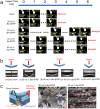Enhancing the Mechanical Toughness of Epoxy-Resin Composites Using Natural Silk Reinforcements
- PMID: 28931868
- PMCID: PMC5607334
- DOI: 10.1038/s41598-017-11919-1
Enhancing the Mechanical Toughness of Epoxy-Resin Composites Using Natural Silk Reinforcements
Abstract
Strong and tough epoxy composites are developed using a less-studied fibre reinforcement, that of natural silk. Two common but structurally distinct silks from the domestic B. mori/Bm and the wild A. pernyi/Ap silkworms are selected in fabric forms. We show that the toughening effects on silk-epoxy composites or SFRPs are dependent on the silk species and the volume fraction of silk. Both silks enhance the room-temperature tensile and flexural mechanical properties of the composite, whereas the more resilient Ap silk shows a more pronounced toughening effect and a lower critical reinforcement volume for the brittle-ductile transition. Specifically, our 60 vol.% Ap-SFRP displays a three-fold elevation in tensile and flexural strength, as compared to pure epoxy resin, with an order of magnitude higher breaking energy via a distinct, ductile failure mode. Importantly, the 60 vol.% Ap-SFRP remains ductile with 7% flexural elongation at lower temperatures (-50 °C). Under impact, these SFRPs show significantly improved energy absorption, and the 60 vol.% Ap-SFRP has an impact strength some eight times that of pure epoxy resin. The findings demonstrate both marked toughening and strengthening effects for epoxy composites from natural silk reinforcements, which presents opportunities for mechanically superior and "green" structural composites.
Conflict of interest statement
The authors declare that they have no competing interests.
Figures




Similar articles
-
Mechanical properties and toughening mechanisms of natural silkworm silks and their composites.J Mech Behav Biomed Mater. 2020 Oct;110:103942. doi: 10.1016/j.jmbbm.2020.103942. Epub 2020 Jun 20. J Mech Behav Biomed Mater. 2020. PMID: 32957236
-
Integrating tough Antheraea pernyi silk and strong carbon fibres for impact-critical structural composites.Nat Commun. 2019 Aug 22;10(1):3786. doi: 10.1038/s41467-019-11520-2. Nat Commun. 2019. PMID: 31439833 Free PMC article.
-
Molecular Interactions and Toughening Mechanisms in Silk Fibroin-Epoxy Resin Blend Films.Biomacromolecules. 2019 Jun 10;20(6):2295-2304. doi: 10.1021/acs.biomac.9b00260. Epub 2019 May 23. Biomacromolecules. 2019. PMID: 31070895
-
Advances in Toughening Modification Methods for Epoxy Resins: A Comprehensive Review.Polymers (Basel). 2025 May 7;17(9):1288. doi: 10.3390/polym17091288. Polymers (Basel). 2025. PMID: 40363071 Free PMC article. Review.
-
Toughening of Epoxy Systems with Interpenetrating Polymer Network (IPN): A Review.Polymers (Basel). 2020 Aug 24;12(9):1908. doi: 10.3390/polym12091908. Polymers (Basel). 2020. PMID: 32847125 Free PMC article. Review.
Cited by
-
Enhanced impact-resistance of aeronautical quasi-isotropic composite plates through diffused water molecules in epoxy.Sci Rep. 2021 Jan 19;11(1):1775. doi: 10.1038/s41598-021-81443-w. Sci Rep. 2021. PMID: 33469122 Free PMC article.
-
Development of Sustainable Rubber Composites Reinforced with Silk Fabric for High-Performance Bicycle Tires: Material Characterization and Prototype Testing.ACS Omega. 2025 Jul 21;10(30):33872-33884. doi: 10.1021/acsomega.5c05422. eCollection 2025 Aug 5. ACS Omega. 2025. PMID: 40787341 Free PMC article.
-
Silk/Natural Rubber (NR) and 3,4-Dihydroxyphenylalanine (DOPA)-Modified Silk/NR Composites: Synthesis, Secondary Structure, and Mechanical Properties.Molecules. 2020 Jan 6;25(1):235. doi: 10.3390/molecules25010235. Molecules. 2020. PMID: 31935972 Free PMC article.
-
Silk as a Natural Reinforcement: Processing and Properties of Silk/Epoxy Composite Laminates.Materials (Basel). 2018 Oct 30;11(11):2135. doi: 10.3390/ma11112135. Materials (Basel). 2018. PMID: 30380733 Free PMC article.
-
Nacreous aramid-mica bulk materials with excellent mechanical properties and environmental stability.iScience. 2020 Dec 26;24(1):101971. doi: 10.1016/j.isci.2020.101971. eCollection 2021 Jan 22. iScience. 2020. PMID: 33490890 Free PMC article.
References
-
- Qu P, Sun X, Ping L, Zhang D, Jia Y. A new numerical model for the analysis on low-velocity impact damage evolution of carbon fiber reinforced resin composites. J. Appl. Polym. Sci. 2016;134:44374.
-
- Nash NH, Young TM, Mcgrail PT, Stanley WF. Inclusion of a thermoplastic phase to improve impact and post-impact performances of carbon fibre reinforced thermosetting composites — A review. Mater. Design. 2015;85:582–597. doi: 10.1016/j.matdes.2015.07.001. - DOI
-
- Río GD, Zaera R, Barbero E, Navarro C. Damage in CFRPs due to low velocity impact at low temperature. Compos. Part. B-Eng. 2005;36:41–50. doi: 10.1016/j.compositesb.2004.04.003. - DOI
-
- Chen Y, Wang S, Liu B, Zhang J. Effects of geometrical and mechanical properties of fiber and matrix on composite fracture toughness. Compos. Struct. 2015;122:496–506. doi: 10.1016/j.compstruct.2014.12.011. - DOI
Publication types
LinkOut - more resources
Full Text Sources
Other Literature Sources

